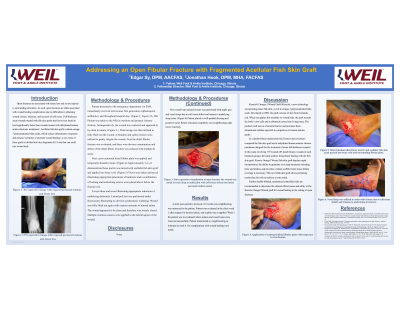Case Series/Study
(CS-144) Addressing an Open Fibular Fracture with Fragmented Acellular Fish Skin Graft

Jonathan Hook, DPM, MHA, FACFAS – Fellowship Director, Weil Foot & Ankle Institute
Introduction: Open fractures are associated with tissue loss and severe injuries to surrounding structures. As such, open fractures are often associated with wound healing complications due to difficulties in obtaining wound closure, infection, and necrosis of soft tissue. Full‐thickness acute wounds treated with fish skin grafts heal have been found to heal significantly faster than wounds treated with dehydrated human amnio‐chorionic membrane.
Methods: Patient presented to the emergency department via EMS, immediately received IV antibiotics throughout hospital stay. Patient was taken to the OR for washout and primary fracture fixation. Pulse lavage was then utilized to fully flush out the wound. Next the distal fibular fracture was evaluated, and there was obvious comminution and defect of the distal fibula. Pre-contoured distal fibular plate was applied and temporally fixated to bone. 3cc of demineralized bone matrix was mixed with acellular fish skin graft and applied into bony void. X-rays taken and saved illustrating appropriate reduction of underlying deformity.
Results: Post-operative protocol of 4 weeks non-weightbearing was instructed to the patient. Patient was evaluated in the clinic week 1 after surgery for incision check, and a splint was re-applied. Week 2 the patient was re-evaluated where sutures and vessel loops were removed successfully. Patient transitioned to weight-bearing as tolerated at week 4. No complications with wound healing were noted.
Discussion: Kerecis is rich in omega-3 polyunsaturated fatty acids. In a double-blind, randomized trial, Kirsner and coworkers compared the fish skin graft and a dehydrated human amnion chorion membrane allograft for the treatment of acute full-thickness wounds. Wound fish skin graft displays rapid incorporation, the ability to granulate over deep structures including bone and tendon, and provides a robust scaffold when tissue deficit coverage is necessary. This novel fish skin graft shows promising results thus far with no adverse events noted.
Trademarked Items:
References: Baldursson BT, Kjartansson H, Konradsdottir F, Gudnason P, Sigurjonsson GF, Lund SH. Healing rate and autoimmune safety of full- thickness wounds treated with fish skin acellular dermal matrix versus porcine small-intestine submucosa: a noninferiority study. Int J Low
Extrem Wounds. 2015;14(1):37-43.
Cross WW, Swiontkowski MF. Treatment principles in the management of open fractures. Indian J Orthop. 2008 Oct-Dec; 42(4): 377-386.
Dorweiler B, Trinh TT, Dunschede F, Vahl CF, Debus ES, Storck M, Diener H. The marine Omega3 wound matrix for treatment of complicated wounds. Gefasschirugie. 2018; 23 (Suppl 2): 45-55.
Kirsner RS, Margolis DJ, Baldursson BT, Petursdottir K, Davidsson OB, Weir D, Lantis JC. Fish skin grafts compared to human amnion/chorion membrane allografts: A double blind prospective, randomized clinical trial of acute wound healing. Wound Repair Regen. 2020 Jan-Feb; 28 (1): 75-80.
Methods: Patient presented to the emergency department via EMS, immediately received IV antibiotics throughout hospital stay. Patient was taken to the OR for washout and primary fracture fixation. Pulse lavage was then utilized to fully flush out the wound. Next the distal fibular fracture was evaluated, and there was obvious comminution and defect of the distal fibula. Pre-contoured distal fibular plate was applied and temporally fixated to bone. 3cc of demineralized bone matrix was mixed with acellular fish skin graft and applied into bony void. X-rays taken and saved illustrating appropriate reduction of underlying deformity.
Results: Post-operative protocol of 4 weeks non-weightbearing was instructed to the patient. Patient was evaluated in the clinic week 1 after surgery for incision check, and a splint was re-applied. Week 2 the patient was re-evaluated where sutures and vessel loops were removed successfully. Patient transitioned to weight-bearing as tolerated at week 4. No complications with wound healing were noted.
Discussion: Kerecis is rich in omega-3 polyunsaturated fatty acids. In a double-blind, randomized trial, Kirsner and coworkers compared the fish skin graft and a dehydrated human amnion chorion membrane allograft for the treatment of acute full-thickness wounds. Wound fish skin graft displays rapid incorporation, the ability to granulate over deep structures including bone and tendon, and provides a robust scaffold when tissue deficit coverage is necessary. This novel fish skin graft shows promising results thus far with no adverse events noted.
Trademarked Items:
References: Baldursson BT, Kjartansson H, Konradsdottir F, Gudnason P, Sigurjonsson GF, Lund SH. Healing rate and autoimmune safety of full- thickness wounds treated with fish skin acellular dermal matrix versus porcine small-intestine submucosa: a noninferiority study. Int J Low
Extrem Wounds. 2015;14(1):37-43.
Cross WW, Swiontkowski MF. Treatment principles in the management of open fractures. Indian J Orthop. 2008 Oct-Dec; 42(4): 377-386.
Dorweiler B, Trinh TT, Dunschede F, Vahl CF, Debus ES, Storck M, Diener H. The marine Omega3 wound matrix for treatment of complicated wounds. Gefasschirugie. 2018; 23 (Suppl 2): 45-55.
Kirsner RS, Margolis DJ, Baldursson BT, Petursdottir K, Davidsson OB, Weir D, Lantis JC. Fish skin grafts compared to human amnion/chorion membrane allografts: A double blind prospective, randomized clinical trial of acute wound healing. Wound Repair Regen. 2020 Jan-Feb; 28 (1): 75-80.

.png)